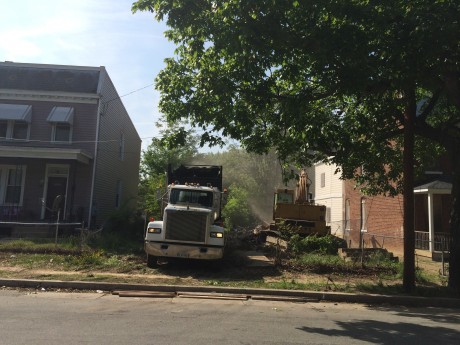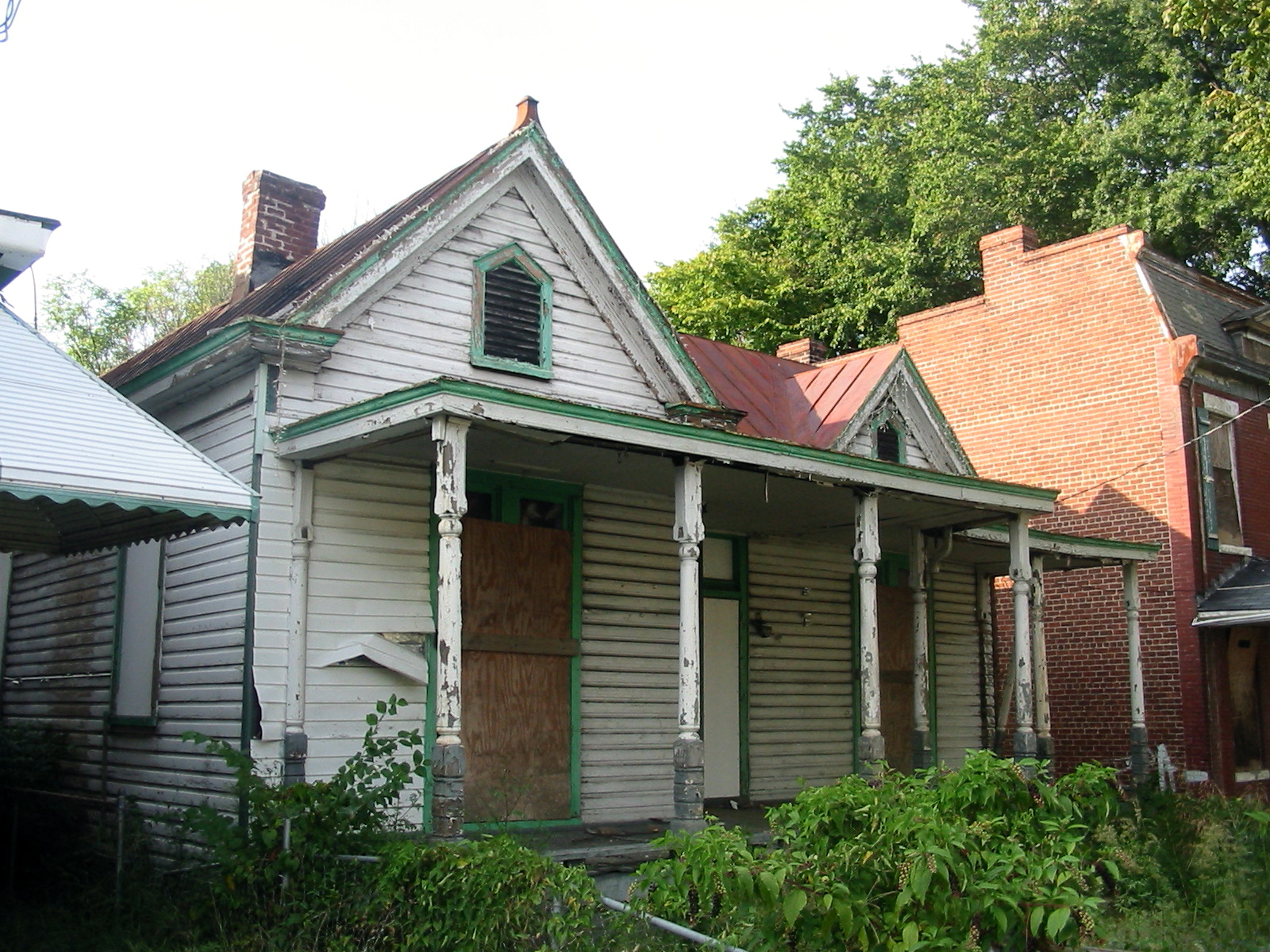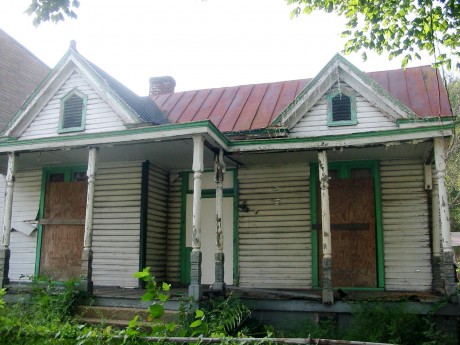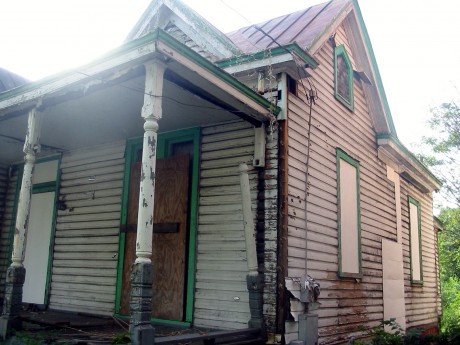The unique little house at 1104 North 20th Street was demolished very recently.
The photos here are from September 2005. The front porch collapsed in 2007 and the house sat vacant and porchless for years.
There is a crew clearing the lot today.
[sep]

[sep]
[sep]




15 comments
Such a shame! That was once a very pretty house, I bet!
Julie Oliver liked this on Facebook.
That’s a real loss. A unique old house!
Too bad…it really doesn’t look like it’s in bad shape so that it couldn’t be rehabbed fairly easily.
That’s a really cute cottage.
Again, the city and owners of historic houses do not care about the holes created when these houses are demolished. They also don’t care about the stories they help tell about the neighborhoods or architectural significance. This house will most likely never be rebuilt. How many other houses like it does the city have? Probably very few. I can only hope someone builds a replica and not a cheap, ugly rip-off.
Can the city tax vacant property at a higher rate? Can the rate climb exponentially the longer it sits vacant? Can the city then sell it all at tax auction (Most of these absentee landlords won’t pay)?
Alternately, how about a Baltimore style 1$ house program (requiring renovation plans and financing, of course)
Or are both/all of these ideas totally unrealistic/unfeasible?
@5 While the house was cute and interesting, the only story it was helping tell was one of decay, blight and neglect.
Not every home can be saved, especially if no one steps up with the money to do the saving. Given some of the homes the city has condemned to demolition that they have not gotten around to months after the fact, that this one was actually knocked down is likely a testament to the reality that it was both dangerous and unlikely to be rehabilitated. The “hole” that was created is better than a dangerous collapse that injures or kills someone.
Let’s also keep in mind that these homes were never intended to last forever. The builders and the original owners never thought they were building the Pyramids. While it is nice to preserve them if and when possible, they were not built to be eternal monuments to their moments in time. Building loss, especially when the structure is uncared for, is to be expected.
@7
While your points are fair – especially your comment that it is unrealistic to expect these homes to last forever, I think you’re overlooking the fact that there are numerous qualities to these buildings that are unique, especially in that if the buildings are not saved, those qualities are not easily replicable.
While the aesthetics (and sometimes the craftsmanship) of period homes greatly exceeds what is currently feasible, there are bigger issues at stake. Due to a combination of labor costs, loss of traditional building arts, standardization, increased materials costs, market inefficiencies, zoning, banking rules, land use and development patterns, (mis)allocation of transportation resources, historic inertia, past racism, and a variety of other systemic/institutional factors; we are in a sort of cultural malaise: Regardless of whether there is anything inherently wrong with suburban sprawl, it is often the only readily available option to most people.
When a building like this is lost – lost not just because the city tears it down but because the city allows it be neglected in the first place – a variety of opportunities and choices for a variety of different people are usually lost with it.
A senior citizen may no longer be able to buy a home in a walkable neighborhood, which they may very well need if they can no longer drive. A young person starting out in the world can no longer buy a fixer upper as a starter home. A person of limited financial means can no longer make a home for themselves through their own labor. An individual concerned about their environmental impact can no longer live in a neighborhood with public transit. An artist looking for an affordable place to live and work can no longer use the space.
This is about more than just history. I suspect people would be less outraged if we were still building row homes and urban cottages on any large scale; and if the ones we were building were more affordable and/or more aesthetically appealing. The loss of these buildings just mean fewer choices.
@8 I would agree that better code enforcement by the city might avoid the level of deterioration to reach this level.
Your comment on the need for housing like this is all well and fine. But in this case either no one was interested in selling or there was no buyer. Perhaps, like the case of a vacant home on my block, the owners are long dead and there is no one to maintain the property.
Even if the city could gain title to the house, if it cannot sell it as is, what recourse does it have to pay for a restoration when it cannot keep the roads and alleys fixed or otherwise provide many basic service.
What you propose is an ideal. Ideals are great, but reality is where the rubber meets the road. The city does not have the money to do wholesale restoration of decaying property. It doesn’t have the resources to put an army of code inspectors on the street to inspect all homes for problems and people would be pissed about it if they did. So unless there is a willing buyer and a way to sell it, this is the appropriate (and really only plausible) outcome if the structure has become hazardous.
One other thing. It is pretty rare when the City designates a property for demolition and then immediately moves forward. There is usually at least a few weeks (and often months) before action is finally taken. People who value these properties and want to protect them also have an obligation to step up and put up the cash to do it. The city doesn’t have it. The current owner cannot or will not. So for those who feel protecting these decaying properties is important have to step up with the money to do the protecting.
Perhaps it’s time for “Houses of Old Richmond Part II”; A photo essay of these unique and in danger houses that will sadly, most likely meet a bull dozer. A shame to lose them and the record of the City’s unique working force houses of the past.
@6 Lee – at least a decade ago, someone named Richard Day proposed the Baltimore style homesteading to city council, and was turned down flat. I don’t know where to find him now, last I heard he was living somewhere off Semmes Ave. I think he was a realtor at some point, but am not even sure of that. You might try to find him and see if he thinks it would pass now. It’s a great idea, and did wonders for B’more. Your comment was the first I’d even thought about it in many years, but it’s worth a try yet again in an effort to reduce urban blight and try to get some of these houses fixed instead of torn by because of neglect.
@6, now that I think of it, maybe he was a mortgage banker back in those days, not a realtor. Anyway, he seriously proposed homesteading and got turned down. At some point, I cheered on folks on this site trying to get a dog park in Chimborazo Park, and hey , it happened. Someone needs to start something like homesteading….
http://www.nytimes.com/1986/01/16/garden/baltimore-s-story-of-city-homestaeding.html
THIS!
@11 CRD- I know Richard Day and have his contact info as I play squash with him. He’s not a realtor but a construction to perm loan officer. If you want to catch up to him, hit me up tiglathpilesar@gmail.com.